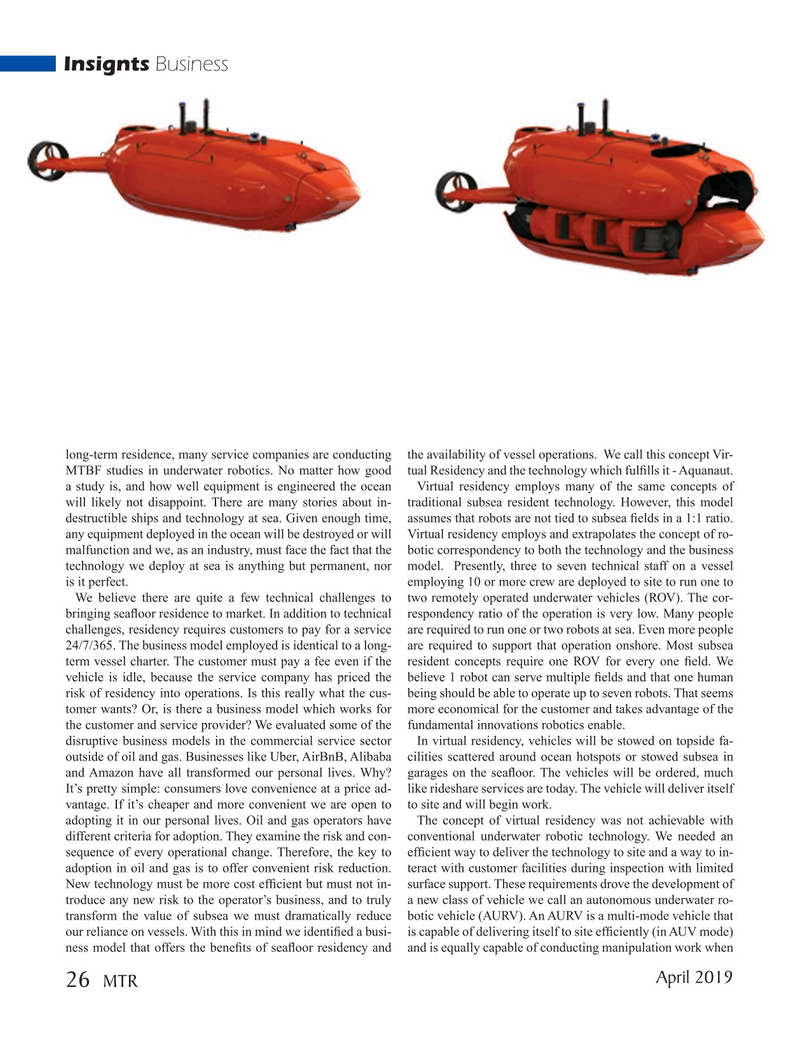
Page 26: of Marine Technology Magazine (April 2019)
Ocean Energy: Oil, Wind & Tidal
Read this page in Pdf, Flash or Html5 edition of April 2019 Marine Technology Magazine
Insignts Business long-term residence, many service companies are conducting the availability of vessel operations. We call this concept Vir-
MTBF studies in underwater robotics. No matter how good tual Residency and the technology which ful? lls it - Aquanaut. a study is, and how well equipment is engineered the ocean Virtual residency employs many of the same concepts of will likely not disappoint. There are many stories about in- traditional subsea resident technology. However, this model destructible ships and technology at sea. Given enough time, assumes that robots are not tied to subsea ? elds in a 1:1 ratio. any equipment deployed in the ocean will be destroyed or will Virtual residency employs and extrapolates the concept of ro- malfunction and we, as an industry, must face the fact that the botic correspondency to both the technology and the business technology we deploy at sea is anything but permanent, nor model. Presently, three to seven technical staff on a vessel is it perfect. employing 10 or more crew are deployed to site to run one to
We believe there are quite a few technical challenges to two remotely operated underwater vehicles (ROV). The cor- bringing sea? oor residence to market. In addition to technical respondency ratio of the operation is very low. Many people challenges, residency requires customers to pay for a service are required to run one or two robots at sea. Even more people 24/7/365. The business model employed is identical to a long- are required to support that operation onshore. Most subsea term vessel charter. The customer must pay a fee even if the resident concepts require one ROV for every one ? eld. We vehicle is idle, because the service company has priced the believe 1 robot can serve multiple ? elds and that one human risk of residency into operations. Is this really what the cus- being should be able to operate up to seven robots. That seems tomer wants? Or, is there a business model which works for more economical for the customer and takes advantage of the the customer and service provider? We evaluated some of the fundamental innovations robotics enable.
disruptive business models in the commercial service sector In virtual residency, vehicles will be stowed on topside fa- outside of oil and gas. Businesses like Uber, AirBnB, Alibaba cilities scattered around ocean hotspots or stowed subsea in and Amazon have all transformed our personal lives. Why? garages on the sea? oor. The vehicles will be ordered, much
It’s pretty simple: consumers love convenience at a price ad- like rideshare services are today. The vehicle will deliver itself vantage. If it’s cheaper and more convenient we are open to to site and will begin work. adopting it in our personal lives. Oil and gas operators have The concept of virtual residency was not achievable with different criteria for adoption. They examine the risk and con- conventional underwater robotic technology. We needed an sequence of every operational change. Therefore, the key to ef? cient way to deliver the technology to site and a way to in- adoption in oil and gas is to offer convenient risk reduction. teract with customer facilities during inspection with limited
New technology must be more cost ef? cient but must not in- surface support. These requirements drove the development of troduce any new risk to the operator’s business, and to truly a new class of vehicle we call an autonomous underwater ro- transform the value of subsea we must dramatically reduce botic vehicle (AURV). An AURV is a multi-mode vehicle that our reliance on vessels. With this in mind we identi? ed a busi- is capable of delivering itself to site ef? ciently (in AUV mode) ness model that offers the bene? ts of sea? oor residency and and is equally capable of conducting manipulation work when
April 2019 26 MTR
MTR #3 (18-33).indd 26 4/12/2019 4:10:26 PM

 25
25

 27
27
